by Laura Tiu | Nov 20, 2017

The lodge at Camp Helen State Park was the perfect backdrop for the Coastal Dune Lake Seminar Series Water School. Brandy Foley of the Choctawhatchee Basin Alliance shares her paleolimnology research work on the lakes.
On a beautiful October day, 35 people gathered at the Camp Helen State Park lodge to share information about the rare Coastal Dune Lakes (CDLs) that line the coast of Walton and Bay Counties. Organized by the University of Florida Extension Programs in Bay and Walton counties, the Water School included a morning seminar series featuring speakers from various groups that work together to support the lakes. Laura Tiu, Sea Grant Agent for Walton and Okaloosa counties started off the day giving a broad overview of the history and ecology of the lakes. Brandy Foley of the Choctawhatchee Basin Alliance shared her research on the paleolimnology, or study of the lake sediments over time, of two coastal dune lakes. Clayton Iron Wolf, a ranger at Camp Helen, gave a summary of the importance of Lake Powell and its benefit to the park. Jeff Talbert of the Atlanta Botanical Garden thrilled attendees with his pictures and research on the Deer Lake State Park restoration project. Norm Capra, who wears many hats, including that of the Lake Powell Community Alliance and Friends of Camp Helen State Park, shared the work they have done promoting conservation of shorebirds there. Dr. Dana Stephens, Director of the Mattie Kelly Environmental Institute at Northwest Florida State College shared analyses of many years of water chemistry and quality data collected on the lakes. Melinda Gates, Environmental Specialist for Walton County, wrapped up with a presentation on the efforts to protect and preserve the lakes.
The attendees seemed pleased with the event with one hundred percent of attendees rating the quality of information presented, usefulness of information, speakers’ knowledge, overall value of the program, and quality of location as good or excellent. The seminar helped attendees identify important roles of the CDLs in the ecosystem and understand why it is important to protect them. Several participants plan to make behavior changes based in the workshop including: joining or volunteering with Choctawhatchee Basin Alliance, Audubon, Sierra Club or Lake Watch Volunteers; sharing the information; living minimally; and engaging in activism. The seminar was followed by a kayak tour lead by Scott Jackson, Bay County Sea Grant Agent, to the outflow of Lake Powell and a visit to a faux sea turtle nest demonstration by Florida Fish and Wildlife Commission. This Water School was part of a regional series offered by UF/IFAS Extension. For more information on future schools, please subscribe to our Panhandle Outdoors Newsletter.

by Laura Tiu | Jun 3, 2017
There are five species of sea turtles that nest from May through October on Florida beaches. The loggerhead, the green turtle and the leatherback all nest regularly in the Panhandle, with the loggerhead being the most frequent visitor. Two other species, the hawksbill and Kemp’s Ridley nest infrequently. All five species are listed as either threatened or endangered under the Endangered Species Act.
Due to their threatened and endangered status, the Fish and Wildlife Conservation Commission/Fish and Wildlife Research Institute monitors sea turtle nesting activity on an annual basis. They conduct surveys using a network of permit holders specially trained to collect this type of information. Managers then use the results to identify important nesting sites, provide enhanced protection and minimize the impacts of human activities.
Statewide, approximately 215 beaches are surveyed annually, representing about 825 miles. From 2011 to 2015, an average of 106,625 sea turtle nests (all species combined) were recorded annually on these monitored beaches. This is not a true reflection of all of the sea turtle nests each year in Florida, as it doesn’t cover every beach, but it gives a good indication of nesting trends and distribution of species.
 If you want to see a sea turtle in the Florida Panhandle, please visit one of the state-permitted captive sea turtle facilities listed below, admission fees may be charged. Please call the number listed for more information.
If you want to see a sea turtle in the Florida Panhandle, please visit one of the state-permitted captive sea turtle facilities listed below, admission fees may be charged. Please call the number listed for more information.
- Gulf Specimen Marine Laboratory, 222 Clark Dr, Panacea, FL 32346 850-984-5297 Admission Fee
- Gulf World Marine Park, 15412 Front Beach Rd, Panama City, FL 32413 850-234-5271 Admission Fee
- Gulfarium Marine Adventure Park, 1010 Miracle Strip Parkway SE, Fort Walton Beach, FL 32548 850-243-9046 or 800-247-8575 Admission Fee
- Navarre Beach Sea Turtle Center, 8740 Gulf Blvd, Navarre, FL 32566 850-499-6774
To watch a female loggerhead turtle nest on the beach, please join a permitted public turtle watch. During sea turtle nesting season, The Emerald Coast CVB/Okaloosa County Tourist Development Council offers Nighttime Educational Beach Walks. The walks are part of an effort to protect the sea turtle populations along the Emerald Coast, increase ecotourism in the area and provide additional family-friendly activities. For more information or to sign up, please email ECTurtleWatch@gmail.com. An event page may also be found on the Emerald Coast CVB’s Facebook page: facebook.com/FloridasEmeraldCoast.

by Laura Tiu | Apr 14, 2017
It was disheartening to read that even with double red flags flying, 22 people had to be recused from the Gulf near Destin, FL recently, and one person lost their life. In that spirit, I believe it is important to review information on the importance of respecting our sometimes-unforgiving gulf.
First of all, stay calm.
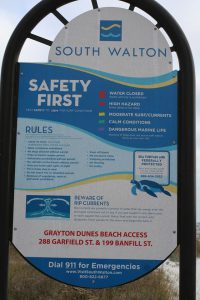
Photo By: Laura Tiu
Swimmers getting caught in rip currents make up the majority of lifeguard rescues. These tips from Florida Sea Grant and the National Oceanic and Atmospheric Administration’s National Weather Service (NWS) can help you know what to do if you encounter a rip current.
What Are Rip Currents?
Rip currents are formed when water flows away from the shore in a channeled current. They may form in a break in a sandbar near the shore, or where the current is diverted by a pier or jetty.
From the shore, you can look for these clues in the water:
- A channel of choppy water.
- A difference in water color.
- A line of foam, seaweed, or debris moving out to sea.
- A break in incoming wave patterns.
If you get caught in a rip current, don’t panic! Stay calm and do not fight the current. Escape the current by swimming across it–parallel to shore–until you are out of the current. When you get out of it, swim back to the shore at an angle away from the current. If you can’t break out of the current, float or tread water until the current weakens. Then swim back to shore at an angle away from the rip current. Rip currents are powerful enough to pull even experienced swimmers away from the shore. Do not try to swim straight back to the shore against the current.
Tips for Swimming Safely
You can swim safely this summer by keeping in mind some simple rules. Many people have harmed themselves trying to rescue rip current victims, so follow these steps to help someone stuck in a rip current. Get help from a lifeguard. If a lifeguard is not present, yell instructions to the swimmer from the shore and call 9-1-1. If you are a swimmer caught in a rip current and need help, draw attention to yourself–face the shore and call or wave for help.
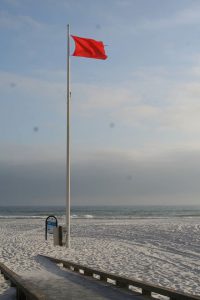
Photo by: Laura Tiu
How Do I Escape a Rip Current?
- Rip currents pull people away from shore, not under the water. Rip currents are not “undertows” or “rip tides.”
- Do not overestimate your swimming abilities. Be cautious at all times.
- Never swim alone.
- Swim near a lifeguard for maximum safety.
- Obey all instructions and warnings from lifeguards and signs.
- If in doubt, don’t go out!
Adapted and excerpted from: “Rip Currents” Florida Sea Grant
The Foundation for the Gator Nation, An Equal Opportunity Institution.
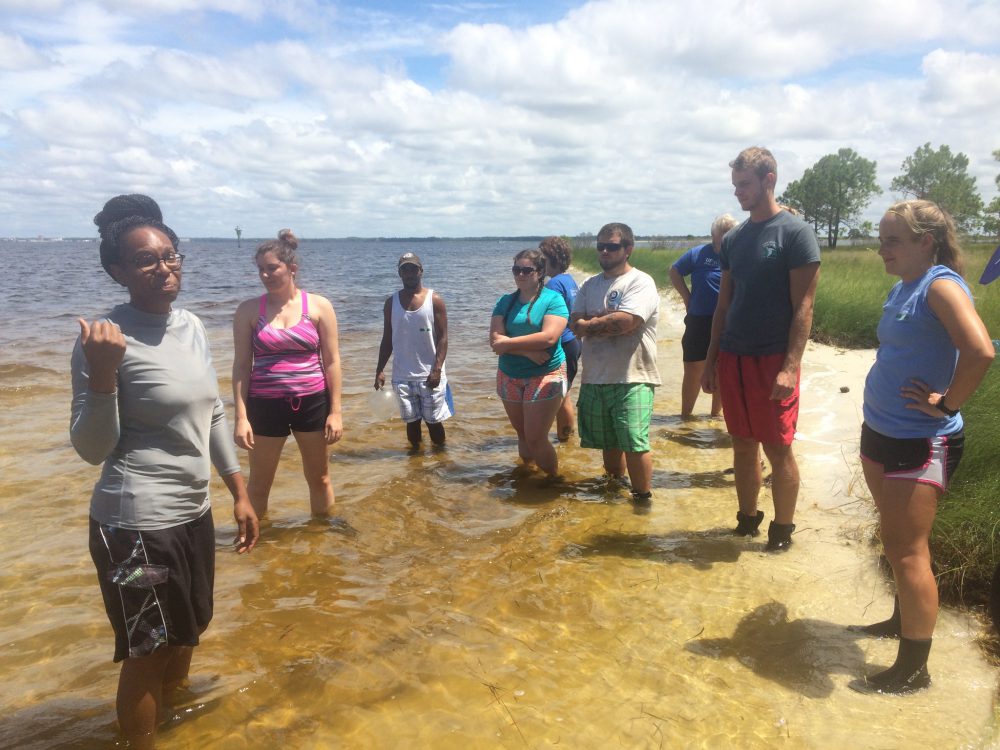
by Laura Tiu | Mar 31, 2017
By: Laura Tiu and Sheila Dunning
For the second year in a row, University of Florida Extension Agents Sheila Dunning (horticulture) and Laura Tiu (marine science) taught a Florida Master Naturalist Program (FMNP) Coastal Module to a newly recruited AmeriCorps group in Okaloosa and Walton counties. The AmeriCorps members have been recruited to work with local the non-profit Choctawhatchee Basin Alliance during the 2016-17 school year teaching Grasses in Classes and Dunes and Schools at the local elementary schools.
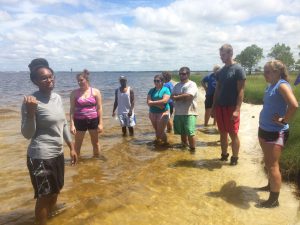
AmeriCorp volunteers learning about coastal environments by attending the Florida Master Naturalist class.
Photo: Laura Tiu
As part of the training, FMNP students participated in an aquatic species collection training to enable them to collect species for touch tanks used throughout the school year. At the training, we met two Fort Walton Beach High School science teachers. Teachers Marcia Holman and Ashley Daniels (an AmeriCorps 2013 member herself) were surprised to see two former students in our AmeriCorps 2016 FMNP class; Dylan and Kaitlyn. Dylan, they reported, was a student that many teachers worried about during his freshman year. However, he just blossomed because of his involvement in the marine classes and environmental ecology club. They were most proud of his leadership designing and implementing a no-balloon graduation ceremony. This prevented the release of potentially harmful balloons into our coastal waterways where they pose a hazard to marine life.
The teachers were so happy to see both students had joined AmeriCorps and were receiving FMNP training. They realized that they were making a difference in the lives of their students and the students they had trained were working to preserve and protect the environment in their communities. When asked if they had any other students that we need to be prepared for Holman replied, “It’s hard to tell at this point in the year if we have any rising marine science stars, but we did have 20 kids show up for the first meeting of the ecology kids club.” We can’t wait to meet them.

by Laura Tiu | Mar 11, 2017
There has been an increasing demand by clientele for information and training on small-scale food production methods to meet the growing demand for locally produced food and for personal consumption. One of the University of Florida Extension’s high-priority initiatives is “increasing the sustainability, profitability, and competitiveness of agricultural and horticultural enterprises.” One food production method currently being investigated is aquaponics.

Koi are a popular fish species used in aquaponic systems.
Photo: Laura Tiu
Aquaponics is a technique for sustainable food production that utilizes the combination of aquaculture with hydroponics to grow fish and vegetables without soil. The process begins with fish producing waste, which is then pumped through a bio-filter to convert into fertilizer for the plants. Plants use nutrients from that water, and the freshly oxygenated water is returned to the fish tank. By recirculating the water from the fish tank to the grow bed, the need for water is greatly reduced compared to traditional irrigation. Additionally, producing crops aquaponically can reduce leaching, runoff, and water discharges to the environment by reusing nutrient effluent from aquaculture and hydroponic systems.
For new growers, being able to have access to training and to see a demonstration unit can eliminate many of the pitfalls typically encountered. A small aquaponics system, using local-sourced materials, is being constructed at the Walton County Extension office in DeFuniak Springs, FL. This system will demonstrate the technology and capability of small-scale aquaponics. The system is expected to be operational in April 2017. Working together, the Sea Grant, Horticulture, and Agriculture agents will be able to share construction and operation information with interested clients. Data will be collected from the system in order to give clientele real-world expectations of the operating costs and production potential from the system. Information will be shared in face-to-face interactions, at workshops, via webinar and in published articles. The goal is to see an increase in the number of aquaponics operations in the Panhandle of Florida contributing to an increase in availability of locally and sustainably produced food.
If you would like to see the system or learn more about aquaponics by subscribing to our Aquaponics list serve, please email Laura Tiu, lgtiu@ufl.edu.
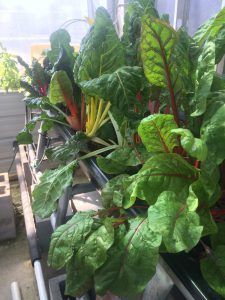
Greens tend to do very well in aquaponic systems.
Photo: Laura Tiu
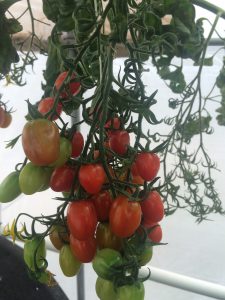
A panhandle favorite, tomatoes can be grown using aquaponics.
Photo: Laura Tiu












